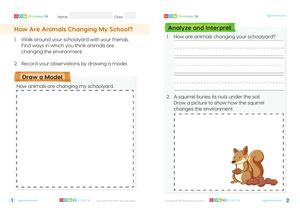Begin the lesson by introducing the concept of tundras as cold, windy, and dry environments. Discuss how these conditions affect the living organisms that inhabit them.
Go to the LessonLearning Objectives
- Understand the basic characteristics of a tundra environment, including its cold, windy, and dry conditions.
- Identify plants that can survive in the tundra, such as grasses, mosses, and small flowering plants.
- Recognize animals that inhabit the tundra, including polar bears, reindeer, snow hares, and foxes.
- Learn how some animals adapt to the changing seasons in the tundra by migrating to warmer areas.
Introduction and Hook
Engage students with a short story or anecdote about an animal or plant that survives in the tundra, sparking curiosity and interest.
Direct Instruction
Explain the basic characteristics of tundra environments, focusing on the cold, windy, and dry conditions.
Introduce the types of plants that can survive in the tundra, such as grasses, mosses, and small flowering plants.
Guided Exploration
Watch the video 'Where Plants and Animals Live' to explore how different species adapt to their environments, including tundras. This video helps students visualize the survival strategies of plants and animals.
Discuss the adaptations of animals like polar bears, reindeer, snow hares, and foxes that allow them to live in the tundra.
Hands-On Activity
Have students create a simple model of a tundra environment using materials like cotton for snow and small toy animals to represent tundra wildlife.
Guide students in planting seeds of tundra plants, such as grasses or mosses, in small pots to observe their growth over time.
Independent Practice
Assign students to draw a picture of a tundra environment, including at least two animals and two plants that live there.
Encourage students to write a short story about a day in the life of a tundra animal, focusing on how it finds food and shelter.
Check for Understanding
Conduct a class discussion to review the characteristics of tundras and the adaptations of plants and animals that live there.
Review and Reflection
Have students share their drawings and stories with the class, reflecting on what they learned about tundra environments.
Encourage students to think about how the knowledge of tundra environments can help in understanding other ecosystems.
Assessment and Extension
Use the assessment 'How Are Animals Changing My School?' to explore how animals adapt to their environments, drawing parallels to tundra animals.
Encourage students to take the unit quiz to test their comprehension of tundra environments and the adaptations of living organisms.
Try the Quiz


